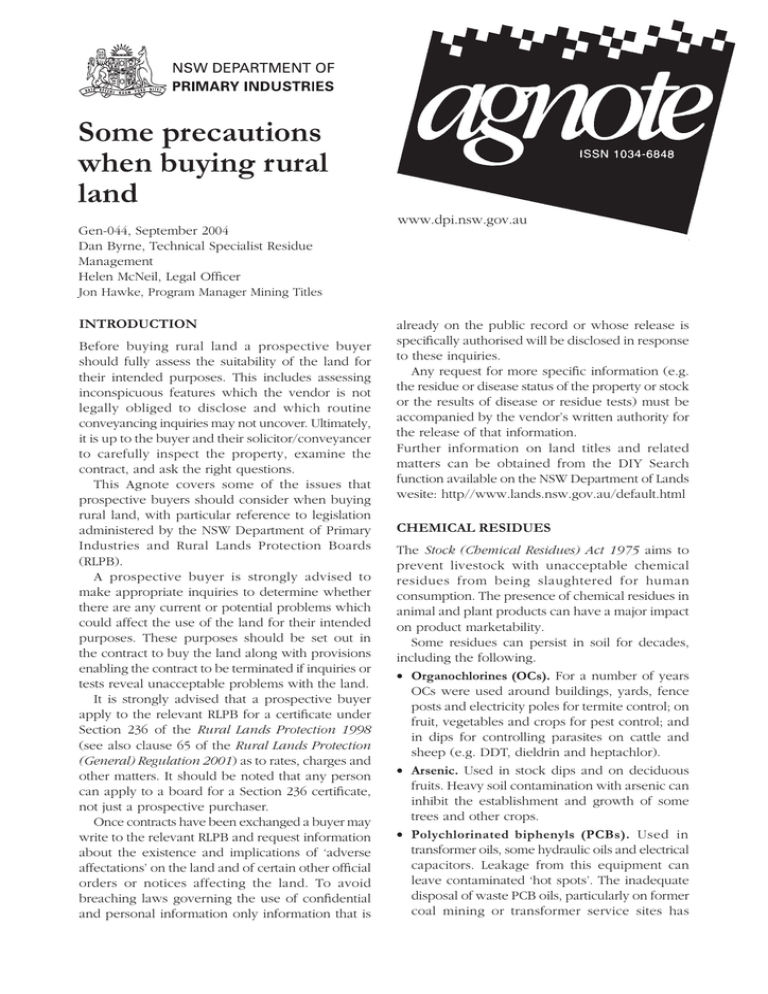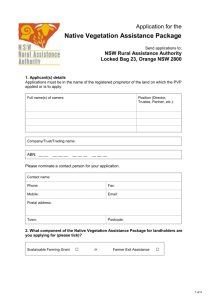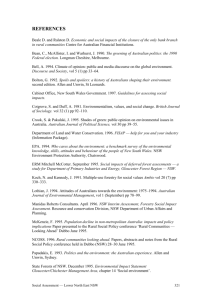Some precautions when buying rural land
advertisement

Some precautions when buying rural land Gen-044, September 2004 Dan Byrne, Technical Specialist Residue Management Helen McNeil, Legal Officer Jon Hawke, Program Manager Mining Titles INTRODUCTION Before buying rural land a prospective buyer should fully assess the suitability of the land for their intended purposes. This includes assessing inconspicuous features which the vendor is not legally obliged to disclose and which routine conveyancing inquiries may not uncover. Ultimately, it is up to the buyer and their solicitor/conveyancer to carefully inspect the property, examine the contract, and ask the right questions. This Agnote covers some of the issues that prospective buyers should consider when buying rural land, with particular reference to legislation administered by the NSW Department of Primary Industries and Rural Lands Protection Boards (RLPB). A prospective buyer is strongly advised to make appropriate inquiries to determine whether there are any current or potential problems which could affect the use of the land for their intended purposes. These purposes should be set out in the contract to buy the land along with provisions enabling the contract to be terminated if inquiries or tests reveal unacceptable problems with the land. It is strongly advised that a prospective buyer apply to the relevant RLPB for a certificate under Section 236 of the Rural Lands Protection 1998 (see also clause 65 of the Rural Lands Protection (General) Regulation 2001) as to rates, charges and other matters. It should be noted that any person can apply to a board for a Section 236 certificate, not just a prospective purchaser. Once contracts have been exchanged a buyer may write to the relevant RLPB and request information about the existence and implications of ‘adverse affectations’ on the land and of certain other official orders or notices affecting the land. To avoid breaching laws governing the use of confidential and personal information only information that is www.dpi.nsw.gov.au already on the public record or whose release is specifically authorised will be disclosed in response to these inquiries. Any request for more specific information (e.g. the residue or disease status of the property or stock or the results of disease or residue tests) must be accompanied by the vendor’s written authority for the release of that information. Further information on land titles and related matters can be obtained from the DIY Search function available on the NSW Department of Lands wesite: http//www.lands.nsw.gov.au/default.html CHEMICAL RESIDUES The Stock (Chemical Residues) Act 1975 aims to prevent livestock with unacceptable chemical residues from being slaughtered for human consumption. The presence of chemical residues in animal and plant products can have a major impact on product marketability. Some residues can persist in soil for decades, including the following. • Organochlorines (OCs). For a number of years OCs were used around buildings, yards, fence posts and electricity poles for termite control; on fruit, vegetables and crops for pest control; and in dips for controlling parasites on cattle and sheep (e.g. DDT, dieldrin and heptachlor). • Arsenic. Used in stock dips and on deciduous fruits. Heavy soil contamination with arsenic can inhibit the establishment and growth of some trees and other crops. • Polychlorinated biphenyls (PCBs). Used in transformer oils, some hydraulic oils and electrical capacitors. Leakage from this equipment can leave contaminated ‘hot spots’. The inadequate disposal of waste PCB oils, particularly on former coal mining or transformer service sites has resulted in more extensive contamination. • Cadmium. High levels of cadmium occur in some soils, particularly those which have been heavily treated with phosphatic fertilisers. Unacceptable cadmium residues can occur in some leafy and root vegetables grown in soils with high cadmium levels and in livestock grazed on such areas. Some livestock diseases can persist on contaminated land even if the property is destocked when sold (e.g. Johne’s disease and anthrax). If the property sale includes stock then a wider range of diseases can carry over, including some that are subject to regulatory control, such as footrot in sheep and enzootic bovine leucosis (EBL) in dairy cattle. A prospective buyer is strongly advised to ask the vendor if the land is subject to any order, notice, undertaking, restriction, prohibition or other ‘adverse affectations’ imposed under the Stock (Chemical Residues) Act 1975. The prospective buyer should also inspect the property for evidence of potentially contaminated sites. These may include: • pesticide storage sheds • used chemical drums or disposal sites • buildings, yards or fences treated for termites • current or abandoned dip sites and rubbish dumps • or abandoned or leaking transformers, capacitors and hydraulic equipment. PLANT DISEASES AND PESTS The Plant Diseases Act 1924 provides powers to control plant diseases and pests. Inspectors can require owners or occupiers to comply with specified conditions under the Act and can destroy neglected fruit trees. Vegetables, fruits, cereals and other crops are susceptible to a wide range of diseases and pests. Soil-borne pests such as phylloxera persist on land, while many other diseases and pests can occur in orchards, pastures and crops that are acquired with the land. Protection zones are declared in parts of NSW to prevent the introduction or spread of specified pests or diseases. Zones are currently in place for: • Fruit fly in the Riverina and lower Murray; • Bunchy top of bananas on the North Coast; • Phylloxera of grape vines in the Murrumbidgee Irrigation Area, Sunraysia, Hunter Valley, Mudgee and Central Tablelands, as well as a number of transitional zones; • Potato cyst nematode and bacterial wilt in seed potatoes in the northern, central and southern highlands; • Diseases of rice in the Riverina. They should also inquire about current and past agricultural practices on the property and in the district, such as intensive vegetable, fruit, cotton or tobacco production, which could increase the risk of soil residues. Soil can also be tested for specified residues. (See Agnote DAI-29, Management of organochlorine and related residues and DPI-380, Testing soils for residues of persistent chemicals.) A prospective buyer should also ask the vendor whether their property identification code (PIC) is on a ‘targeted testing list’ or the property has a ‘residue management plan’, and for any other available information about the property’s residue history. A prospective buyer who intends to operate a horticultural or cropping enterprise should make themselves aware of relevant disease and pest problems, protection zones and regulations which apply in that district. Information regarding the disease/pest history and current status of the property should be sought from the vendor. LIVESTOCK DISEASES The Stock Diseases Act 1923 aims to control proclaimed diseases of livestock. Stock movements may be restricted and stock owners may be required to treat infected or at-risk stock. Protection zones are declared in some parts of NSW to prevent the introduction or spread of specific diseases. Zones are currently in place in certain areas in NSW for footrot in sheep and for cattle tick in grazing livestock. A prospective buyer should ask the vendor whether the property’s herd or flock is covered by any ‘market assurance programs’. They should also ask about disease risks or problems in the stock and the control measures being used and whether the land is subject to any order, notice, declaration, undertaking, authorisation or other ‘adverse affectation’ issued under the Stock Diseases Act 1923. NOXIOUS WEEDS The Noxious Weeds Act 1993 makes the occupier of land responsible for the control of specific weeds which can spread and cause problems for other landholders. The list of declared noxious weeds varies from district to district. When an occupier fails to comply with the obligations of the Act the local weed authority, usually the local council, may issue a weed control notice under Section 18 requiring the occupier, at their expense, to carry out specified weed control work. If this work is not done, the authority may 2 initiate legal proceedings or carry out the work and recover costs from the occupier. After land is sold, the new owner or occupier may be bound by previous notices issued in respect of the land and liable for any outstanding costs incurred under the Act. It is strongly advised that a prospective buyer apply to the relevant authority for a certificate stating whether any weed control notices are in force or any expenses are payable for the land. They should also ask the vendor about any weed problems. Many common weeds that are not declared noxious can also affect productivity, quality and saleability of produce, or amenity of the property. Prospective buyers should therefore inspect the land for weeds, realising that they might not be evident at certain times of the year. land subdivision and establishing guidelines for the design and construction of building and utility services. As part of the State’s land conveyancing system, the Board issues certificates on request to prospective land purchasers. These certificates inform the purchaser: • whether the land is within a Mine Subsidence District; • whether the Board’s approval has been obtained for any improvements or alterations to improvements on the land; and • whether the improvements have been the subject of any claims for subsidence damage. NOXIOUS ANIMALS AND INSECTS The Rural Lands Protection Act 1998 requires landholders to actively control noxious animals such as rabbits, wild dogs, pigs and noxious insects such as plague locusts. After the exchange of contracts, RLPBs can advise potential buyers of any current order under Section 143 or general eradication order under Section 157. An existing order extends to the new owner or occupier and places the same obligations on them. The prospective buyer should inspect the property for signs of noxious animals and insect activity, and ask the current owner about any pest problems they experience. MINING AND MINERAL EXPLORATION Rural land may be subject to mining and exploration titles or applications under the Mining Act 1992 or Petroleum (Onshore) Act 1991. It is recommended that prior to rural land purchase, the purchaser or their solicitor submit an ‘application for search’ (cost $50.00 plus $5.00 GST) to the NSW Department of Primary Industries, Mineral Resources to determine if this is the case. The most common form of affectation is by exploration title (exploration licence, coal authorisation, petroleum exploration licence) and in a large majority of such cases, any activity under the title will not actually physically occur on most individual properties within the title area. Even if exploration activity is proposed to occur on an individual property, it can only be carried out subject to a specific ‘access arrangement’ under Section 140 of the Mining Act 1992 or Section 69C of the Petroleum (Onshore) Act 1991, agreed to with the land owner and occupier. Exploration activity usually is of a short-term nature and generally has minimal environmental impact. A mining lease or proposed mining lease is usually of considerable significance to landholders and should be carefully investigated before land purchase. Mining leases are relatively uncommon except in well known mining regions. They are usually preceded by relatively intense exploration activity. A further matter that should be investigated in current and former underground coal mining areas in the Hunter Valley, Newcastle, Wollongong– Campbelltown, Central Coast, and Lithgow areas is whether a property lies within a Mine Subsidence District proclaimed under the Mine Subsidence Compensation Act 1961. Within Mine Subsidence Districts, the Mine Subsidence Board has the power to regulate surface land use by controlling OTHER CONDITIONS OF LAND USE There are a number of other factors which could affect people buying rural land. • As well as local council rates, most rural land is subject to annual RLPB rates. Additional rates and fees apply in the western division. • Buyers of crown leases should be aware of the special conditions and obligations which apply. • Many farming industries are subject to licensing and other legal requirements designed, for example, to assist disease control, allow traceback of produce, or provide for orderly marketing arrangements. People must familiarise themselves with these requirements before engaging in an agricultural enterprise. • High soil levels of certain chemical residues can impose constraints on where a house can be built. The local council, Department of Infrastructure, Planning and Natural Resources, Department of Environment and Conservation and other Government agencies control various aspects of rural 3 land use, covering areas as diverse as development and building approval, land clearing, irrigation, and intensive livestock production. Further information may be sought from these agencies. DISCLAIMER The information contained in this publication is based on knowledge and understanding at the time of writing (September 2004). However, because of advances in knowledge, users are reminded of the need to ensure that information upon which they rely is up to date and to check currency of the information with the appropriate officer of NSW Department of Primary Industries or the user’s independent adviser. LAND USE PLANNING There are many features of agricultural land which may not be governed by legislation but which can significantly affect the land’s suitability, productivity, amenity and value. These include natural features such as topography, climate, soils, water availability, and natural vegetation. Infrastructure and other improvements such as road access, sheds, yards, fences, water and power supply, established crops, plantations, aquaculture or horticulture and overall farm layout are also important. The viability of any proposed agricultural enterprise or pursuit should be closely examined before the land is bought with that purpose in mind. Marketing, enterprise requirements, farm planning, farming techniques and business management should all be examined. A person wishing to obtain information on the productive potential use of a property should contact a private consultant. Agdex 687 This Agnote replaces Agnote DAI-31. 4 Table 1. Sources of information. This checklist is a guide only. It is not exhaustive or applicable to every rural property. Things to consider when buying rural land Chemical residues □ History and current status of property □ Official orders and notices ¶ □ Presence of contaminated sites □ Constraints on development and land use □ Advice on programs and problems§ □ Soil Testing Livestock diseases □ History and current status of property □ Zones □ Official orders and notices¶ □ Advice on programs and problems§ Sources of Information □ Vendor □ Rural Lands Protection Board # □ Vendor, property inspection, Department of Environment and Conservation, Local Council □ Department of Environment and Conservation, Local Council □ Rural Lands Protection Board # (animals) □ Analysts □ Vendor □ Rural Lands Protection Board # □ Rural Lands Protection Board # □ Veterinary surgeons, publications Plant diseases and pests □ History and current status of property □ Zones □ Advice on programs and problems§ Noxious weeds □ Presence □ Outstanding weed control notices ¶ □ Advice on programs and problems§ Noxious animals and insects □ Presence □ Outstanding control orders ¶ □ Advice on programs and problems§ Mining and mineral exploration □ current status of property □ subsidence issues Other conditions of land use □ Zoning, development, building approval, easements, covenants, resumptions □ Bores, dams, irrigation, land clearing □ Rates, crown leases Land use planning □ Natural features, infrastructure and improvements, enterprise viability □ Vendor □ NSW Department of Primary Industries* □ Agricultural consultants, publications □ Property inspection, vendor □ Local Council or weed authority □ Local Council, agricultural consultants, publications □ Property inspection, vendor □ Rural Lands Protection Board # □ Rural Lands Protection Board #, publications □ Vendor, NSW Department of Primary Industries □ Mine Subsidence Board □ Local Council, various government agencies □ Dept. of Infrastructure, Planning and Natural Resources (DIPNR) □ Local Council, RLPB#, Western Lands Commission □ Property inspection □ Local knowledge and records □ Agricultural consultants, analysts, boring contractors, irrigation suppliers, electricity supplier □ Advisory publications, books, magazines, newspapers □ Short courses, seminars and field days run by agricultural and TAFE colleges, adult education centres, industry associations, rural suppliers, NSW Department of Primary Industries □ Business enterprise centres ¶ Official orders and notices may only be disclosed on written request and after exchange of contracts. § Government agencies and local authorities can only provide general advice relating to the district unless the current owner gives written permission for the release of specific information about their land. # See Rural Lands Protection Board in the local white pages telephone directory. * See under Agriculture NSW or NSW Department of Primary Industries in the local white pages or on the internet at http://www.agric.nsw.gov.au or http://www.dpi.nsw.gov.au/reader/contact-us Note: From July 2004, NSW Agriculture, Department of Mineral Resources, NSW Fisheries and State Forests of NSW have been incorporated into the NSW Department of Primary Industries 5






